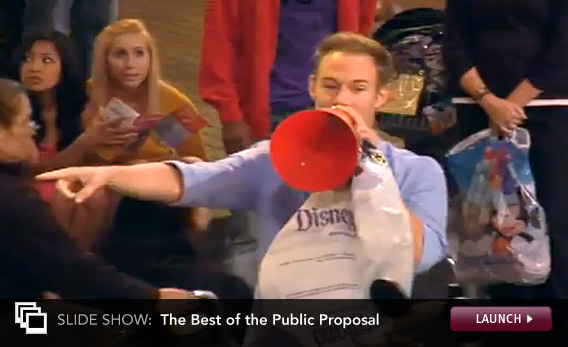
In 1901, Chicago author Myrtle Reed complained that most men fell short when it came to popping the question. In her guide to men, courting and marriage called The Spinster Book, Reed wrote that potential grooms "propose as thoughtlessly and easily as they dress for dinner," and "devote no particular study to the art."
Too bad Reed couldn't be around to see the YouTube video documenting Matt Still's proposal to Ginny Joiner. Still produced a homemade movie trailer and convinced a local movie theater to roll his amateur film alongside the other previews. Or Corey Newman's personalized crossword puzzle in the Washington Post: Newman rigged the answers to pose the question: "Marlowe Epstein will you marry me?"
Today, men are proposing marriage via Groupon deals, tweets and flash mobs in Washington Square Park. In a 2009 survey of 20,000 brides by theknot.com and wedding.com, 32 percent said they received a public marriage proposal. In 2010, that number jumped to 43 percent. Before 2009, the survey didn't ask the question. So how did we get from Myrtle Reed's era of bumbling, private proposals to the extravagant rituals of today?
It was no Scrabble-themed 'Will You Marry Me?" mural in the middle of New York City, but the public marriage announcement started in 17th-century New England. The Protestants of the early colonies introduced a tradition called "declaring banns," and insisted a new couple hang a public proclamation of an impending marriage outside town hall for three consecutive Sundays. If a member of the community objected to the union, he or she had time to air any doubts.
In the late 19th century, the proposal started to become more romantic. Before that, marriages were often arranged, and more like business transactions than loving unions. "The idea of one person getting down on his knee didn't exist," explains Elizabeth Abbott, author of A History of Marriage. "The proposal was an afterthought to the concrete arrangement that came before." As love became a leading factor in the decision to tie the knot, it coincided with a societal movement toward individual contentment; young people began to associate marriage with happiness, love, and erotic satisfaction.
Still, even when a couple was in love, the proposal remained a private affair. In a 1922 book, Fascinating Womanhood, or the Art of Attracting Men, the author advises young women on how to elicit a marriage proposal. When going out to eat, "Avoid the dazzlingly white restaurants, the gay and glittering kind, and the cabarets ? their atmosphere discourages all thought of home and marriage."
While the wedding industry surged after World War II, the glossy extravaganzas we know today began during the Reagan administration. "In the 1960s and 70s, it wasn't even popular to get married," explains Chrys Ingraham, a professor of sociology at Purchase College SUNY and author of White Weddings. "During the sexual revolution, it was actually considered sort of goofy," Others who didn't find marriage goofy?like some feminists?thought the entire institution was a form of female servitude. They likely would've torn up Corey Newman's crossword puzzle and walked out of the theater as soon as Matt Still's preview began to play.
But the free-love, anti-institutional war cry of the '60s quieted during the mid-1970s and early 1980s. Then the crippling recession of the early 1980s struck and imposed a new set of economic realities on the once-carefree generation. Marriage became a pragmatic decision. For young people, the free-loving "fantasy world [of the 1960s] had dissipated by the 1980s," explains Elizabeth Abbott.
Some experts attribute the commercialization of the wedding industry to the fairy-tale wedding of Princess Diana and Prince Charles in 1981. The wedding drew 750 million viewers from around the world, inspiring bridal excess everywhere. "In America, the effect was immediate," write Elizabeth Pleck and Cele Otnes, authors of Cinderella Dreams: The Allure of the Lavish Wedding. The new atmosphere launched groups like the Association of Bridal Consultants, created to feed brides hungry for professionals skilled in planning such lavish ceremonies, as well as Martha Stewart's Weddings book, which debuted in 1987.
Naturally, once weddings morphed into theatrical events, proposals followed suit. In 1985, sportscaster Ahmad Rashad proposed to Phylicia Ayers-Allen (better known as mom Clair Huxtable on The Cosby Show) on television before the Thanksgiving Day football game between the New York Jets and the Detroit Lions. Bill Ponath takes credit for orchestrating the first JumboTron scoreboard proposal on Jan. 2, 1987, at the National Fiesta Bowl.
Elizabeth Weingarten is a Slate editorial assistant.Source: http://feeds.slate.com/click.phdo?i=5240293b56bc216fdc8fd73445e7a2e1
local news cache gisele bundchen hemangioma anthony hopkins patent ku
No comments:
Post a Comment
Note: Only a member of this blog may post a comment.